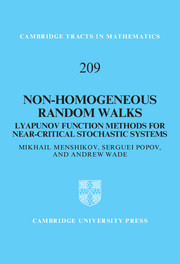Crossref Citations
This Book has been
cited by the following publications. This list is generated based on data provided by Crossref.
Comets, Francis
and
Popov, Serguei
2017.
The vacant set of two-dimensional critical random interlacement is infinite.
The Annals of Probability,
Vol. 45,
Issue. 6B,
Jacq, Thomas S.
and
Lardizabal, Carlos F.
2017.
Open Quantum Random Walks on the Half-Line: The Karlin–McGregor Formula, Path Counting and Foster’s Theorem.
Journal of Statistical Physics,
Vol. 169,
Issue. 3,
p.
547.
Montero, Miquel
2017.
Quantum and random walks as universal generators of probability distributions.
Physical Review A,
Vol. 95,
Issue. 6,
Menshikov, Mikhail V.
Petritis, Dimitri
and
Wade, Andrew R.
2018.
Heavy-Tailed Random Walks on Complexes of Half-Lines.
Journal of Theoretical Probability,
Vol. 31,
Issue. 3,
p.
1819.
Jordan, Jonathan
2018.
The connected component of the partial duplication graph.
Latin American Journal of Probability and Mathematical Statistics,
Vol. 15,
Issue. 2,
p.
1431.
Georgiou, Nicholas
Mijatović, Aleksandar
and
Wade, Andrew R.
2018.
A radial invariance principle for non-homogeneous random walks.
Electronic Communications in Probability,
Vol. 23,
Issue. none,
Costa, M.
Menshikov, M.
Shcherbakov, V.
and
Vachkovskaia, M.
2018.
Localisation in a Growth Model with Interaction.
Journal of Statistical Physics,
Vol. 171,
Issue. 6,
p.
1150.
Kizinevič, Edita
and
Šiaulys, Jonas
2018.
The Exponential Estimate of the Ultimate Ruin Probability for the Non-Homogeneous Renewal Risk Model.
Risks,
Vol. 6,
Issue. 1,
p.
20.
Shcherbakov, Vadim
and
Volkov, Stanislav
2019.
Boundary effect in competition processes.
Journal of Applied Probability,
Vol. 56,
Issue. 3,
p.
750.
Janson, Svante
Shcherbakov, Vadim
and
Volkov, Stanislav
2019.
Long Term Behaviour of a Reversible System of Interacting Random Walks.
Journal of Statistical Physics,
Vol. 175,
Issue. 1,
p.
71.
Barreto, Yan B.
Rodrigues, Matheus L.
and
Alencar, Adriano M.
2019.
Transport cycle ofEscherichia colilactose permease in a nonhomogeneous random walk model.
Physical Review E,
Vol. 99,
Issue. 5,
Gantert, Nina
Popov, Serguei
and
Vachkovskaia, Marina
2019.
On the range of a two-dimensional conditioned simple random walk.
Annales Henri Lebesgue,
Vol. 2,
Issue. ,
p.
349.
Birkner, Matthias
Gantert, Nina
and
Steiber, Sebastian
2019.
Coalescing directed random walks on the backbone of a 1+1-dimensional oriented percolation cluster converge to the Brownian web.
Latin American Journal of Probability and Mathematical Statistics,
Vol. 16,
Issue. 2,
p.
1029.
Georgiou, Nicholas
Mijatović, Aleksandar
and
Wade, Andrew R.
2019.
Invariance principle for non-homogeneous random walks.
Electronic Journal of Probability,
Vol. 24,
Issue. none,
Dolgopyat, Dmitry
and
Goldsheid, Ilya
2019.
Invariant measure for random walks on ergodic environments on a strip.
The Annals of Probability,
Vol. 47,
Issue. 4,
Georgiou, Nicholas
Menshikov, Mikhail V.
Petritis, Dimitri
and
Wade, Andrew R.
2019.
Markov chains with heavy-tailed increments and asymptotically zero drift.
Electronic Journal of Probability,
Vol. 24,
Issue. none,
Alsmeyer, Gerold
and
Raschel, Kilian
2019.
The extinction problem for a distylous plant population with sporophytic self-incompatibility.
Journal of Mathematical Biology,
Vol. 78,
Issue. 6,
p.
1841.
Sun, Rongfeng
Swart, Jan M.
and
Yu, Jinjiong
2019.
Equilibrium interfaces of biased voter models.
The Annals of Applied Probability,
Vol. 29,
Issue. 4,
Barreto, Yan B.
Suki, Béla
and
Alencar, Adriano M.
2020.
Random-walk model of cotransport.
Physical Review E,
Vol. 102,
Issue. 2,
Pozzoli, Gaia
Radice, Mattia
Onofri, Manuele
and
Artuso, Roberto
2020.
A Continuous-Time Random Walk Extension of the Gillis Model.
Entropy,
Vol. 22,
Issue. 12,
p.
1431.



